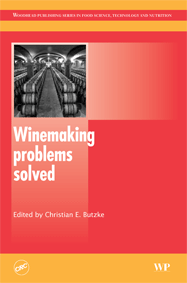Winemaking Problems Solved, edited by Christian E. Butzke
| Title of book: | Winemaking Problems Solved |
| Author: | Ed. Christian E. Butzke |
| Publisher: | Woodhead Publishing |
| Publication date: | July 2010 |
| ISBN | 978 1 84569 475 3 |
| Pages: | 398 |
| Price: | £135.00 / US$230.00 / €160 +P&P |
 This is a bit like the wine equivalent of the Haynes car repair manual. It’s divided into subject groups, and within each category follows a useful question and answer format.
This is a bit like the wine equivalent of the Haynes car repair manual. It’s divided into subject groups, and within each category follows a useful question and answer format.
It doesn’t deal with any pro-active or preventative ‘winemaking’ in the vineyard, but deals with issues as they arise and may be experienced in the winery. So the book is targeting to be a ‘real time’ tool. Perhaps the preventative approach comes by reading it before the harvest.
As well as ‘pure’ winemaking issues, those of packaging finished wine and questions about winemaking equipment are included, with some questions appearing quite simple but yielding interesting and useful information, at least for a non-winemaker. For example, how many corks out of a 5,000 cork bale would I need to sample to assure a taint rate of less than one bottle in five cases? And, what is stainless steel? And, how do I clean my wine tanks? The latter question yields a 33 point action plan.
If the technicalities and options of problem-solving in winemaking have a regional bias, then it may be found here, as all the academic contributors are from USA institutions. In addition there are one or two non-academic contributions from practitioners outside the USA. Does this mean one should interpret that the USA has particular issues with Brettanomyces spoilage, as a full 54 pages are devoted to it; that’s more than 1/8th of the entire book. Or is Brettanomyces a growing global issue that needs detailed attention? Nonetheless there are eminent names in the list of contributors.
Other answers are extremely succinct, for example, does filtration affect wine quality? Answer – yes … but in both ways – it can clean up a wine, or take stuff out. Or, what is a yeast strain? Though this latter point doesn’t really qualify as problem-solving.
There is a mix of this type of short, information-providing entry of definitions, alongside the more detailed practical entries like how to perform a bubble point membrane filter integrity test, or how to store and rehydrate malolactic starter cultures. And while this is not an exhaustive manual on things that can go awry during winemaking and how to fix them, there is useful information here.



